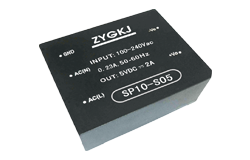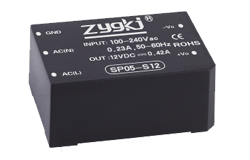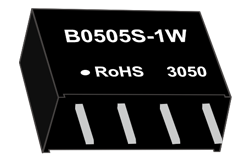news
24V AC to DC Converter: Converting Alternating Current to Direct Current
Author: ZYG Power Module Time: 2023-5-15
A 24V AC to DC converter is a device that is used to convert alternating current (AC) to direct current (DC). This type of converter is commonly used in electronic devices and equipment that require a stable and consistent power supply. In this article, we will discuss the basic principles of AC to DC conversion, the different types of 24V AC to DC converters, and their applications.
Principles of AC to DC Conversion
AC power is supplied to most homes and buildings through the power grid. AC power changes direction and magnitude periodically, which means that the voltage level of the power supply may vary over time. In contrast, DC power flows in only one direction and maintains a constant voltage level.
To convert AC power to DC power, a 24V AC to DC converter first rectifies the AC signal, which means that it converts the AC signal into a pure DC signal. Then, it filters and regulates the DC signal to ensure that it has a stable voltage level.
Types of 24V AC to DC Converters
There are several types of 24V AC to DC converters, each with its own advantages and disadvantages. The most common types are:
1. Linear regulators: Linear regulators are simple and inexpensive, but they are not very efficient and can generate a lot of heat.
2. Switching regulators: Switching regulators are more complex and expensive, but they are more efficient and generate less heat than linear regulators. They are often used in high-power applications.
3. Buck converters: Buck converters are a type of switching regulator that can step down the voltage of the input signal.
4. Boost converters: Boost converters are a type of switching regulator that can step up the voltage of the input signal.

Applications of 24V AC to DC Converters
24V AC to DC converters are used in a wide range of applications, including:
1. Power supplies for electronic devices and equipment, such as computers, televisions, and audio systems.
2. Battery charging systems for electric vehicles, boats, and other mobile applications.
3. Solar power systems, where the incoming power is DC, but must be converted to AC for use in homes and businesses.
4. LED lighting systems, where the incoming power is AC, but must be converted to DC for use in the LED lights.
Conclusion
In conclusion, a 24V AC to DC converter is an essential device that is used in many different applications. By converting AC power to DC power, the converter ensures that electronic devices and equipment receive a stable and consistent power supply. There are several different types of 24V AC to DC converters, each with its own advantages and disadvantages, and they are used in a wide range of applications, from power supplies to solar power systems and LED lighting.
relevant information
-
2023-7-26
Efficient AC to DC Converter for LED Lighting: 12V Power Solution
Introduction In recent years, there has been a significant shift towards energy-efficient lighting solutions. LED lighting has emerged as a popular choice due to its long lifespan, low power consumption, and eco-friendly nature. However, to power these LED lights, an efficient AC to DC converter is required. This article aims to explore the importance of an efficient AC to DC converter for LED lighting and introduce a 12V power solution. The Need for an AC to DC Converter LED lights are designed to operate on low voltage DC power. However, in most households and commercial buildings, the main power supply is AC (alternating current). Therefore, an AC to DC converter is necessary to convert the AC power into the required...
View details -
2023-5-24
Efficient 24V AC to DC Converter for Smooth Power Conversion
In today's world, power conversion is a critical aspect of modern technology. A significant amount of electronic equipment requires a stable and regulated power supply to function correctly. One of the most commonly used power conversion methods is the AC to DC converter. An AC to DC converter performs the essential task of converting alternating current (AC) to direct current (DC). In this article, we will be discussing the efficient 24V AC to DC converter for smooth power conversion. The primary objective of this converter is to convert AC power to DC power with minimal losses and provide a constant DC voltage output. The 24V AC to DC converter is widely used in various electronic applications, such as in computers,...
View details -
2023-4-12
Creating an AC-DC Converter: A Guide to Converting Alternating Current to Direct Current
If you work with electronics, you may find yourself needing to convert AC (alternating current) to DC (direct current) at some point. This can be done with a simple AC-DC converter circuit. In this guide, we walk you through the process of creating your own converter circuit. First things first, let\ explain the difference between AC and DC. Alternating current is the kind of electricity that comes out of your wall socket. It oscillates back and forth, changing direction 50 or 60 times per second. Direct current, on the other hand, flows in one direction only. Most electronic devices require DC to function. To create an AC-DC converter, you need a few basic components. These include a transformer, a diode...
View details -
2023-5-2
Designing an AC-DC Converter Circuit
Introduction AC-DC converters are electronic circuits used to convert an AC voltage to a DC voltage. These circuits are used in a wide range of devices, including power supplies for electronic equipment, battery chargers, and LED drivers. In this article, we will discuss the design of an AC-DC converter circuit. Design Considerations The design of an AC-DC converter circuit involves several considerations, including the input voltage, output voltage, output current, and efficiency. The input voltage is the AC voltage that is to be converted to DC. The output voltage is the DC voltage required for the load. The output current is the current that the load requires. The efficiency is the ratio of the output power to the input power....
View details -
2023-6-21
Revolutionizing Illumination: The LED Power Series
Light-emitting diodes or LEDs have been around since the 1960s. In recent years, however, they have become increasingly popular as a source of illumination. LEDs are being used in a wide variety of applications such as traffic signals, automotive lighting, and outdoor lighting. They are also becoming more popular in homes and businesses as a source of general lighting. LEDs have many advantages over traditional incandescent and fluorescent bulbs, including energy efficiency, longer life, and a smaller carbon footprint. In this article, we will discuss the LED Power Series and how it is revolutionizing illumination. The LED Power Series is a line of high-performance LED lights designed for a variety of applications. These lights are engineered to provide maximum efficiency...
View details -
2023-7-9
Unleashing the Power of Communication: The Advantages of a Bidirectional Converter
In today's interconnected world, effective communication is crucial for the smooth functioning of various industries and sectors. Whether it is transmitting information between devices, converting data signals, or allowing different systems to communicate seamlessly, the role of a bidirectional converter cannot be underestimated. In this article, we will explore the numerous advantages of a bidirectional converter and its impact on enhancing communication capabilities. A bidirectional converter, as the name suggests, is a device that can convert signals in two directions. It can convert data from one type to another and vice versa. This flexibility allows for efficient communication between different systems, ensuring compatibility, and enabling the exchange of vital information. One of the significant advantages of a bidirectional converter is...
View details


















